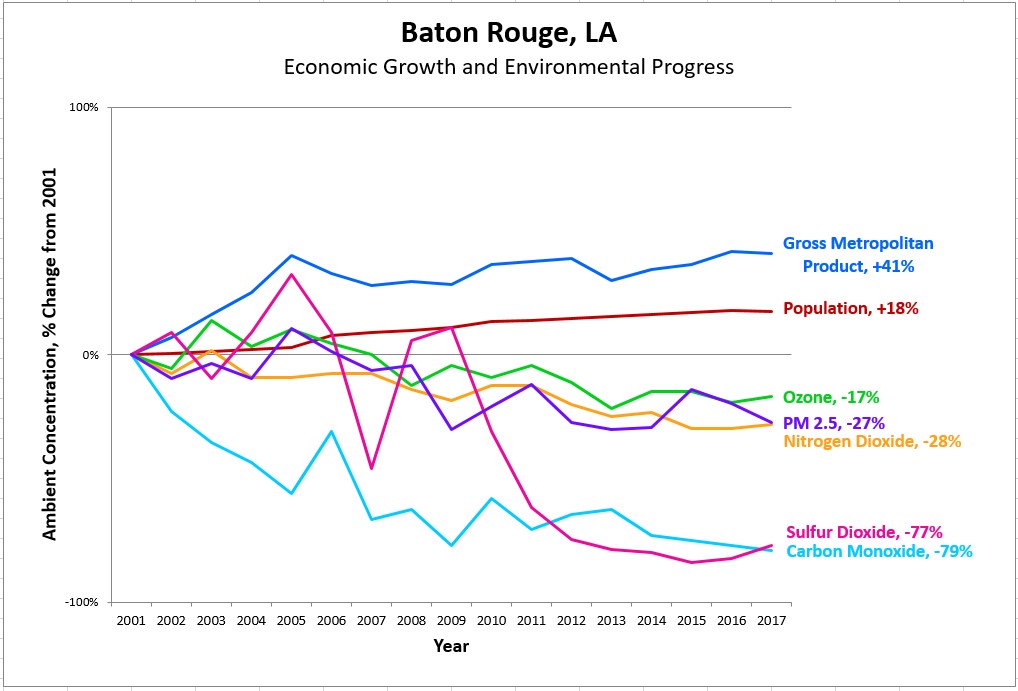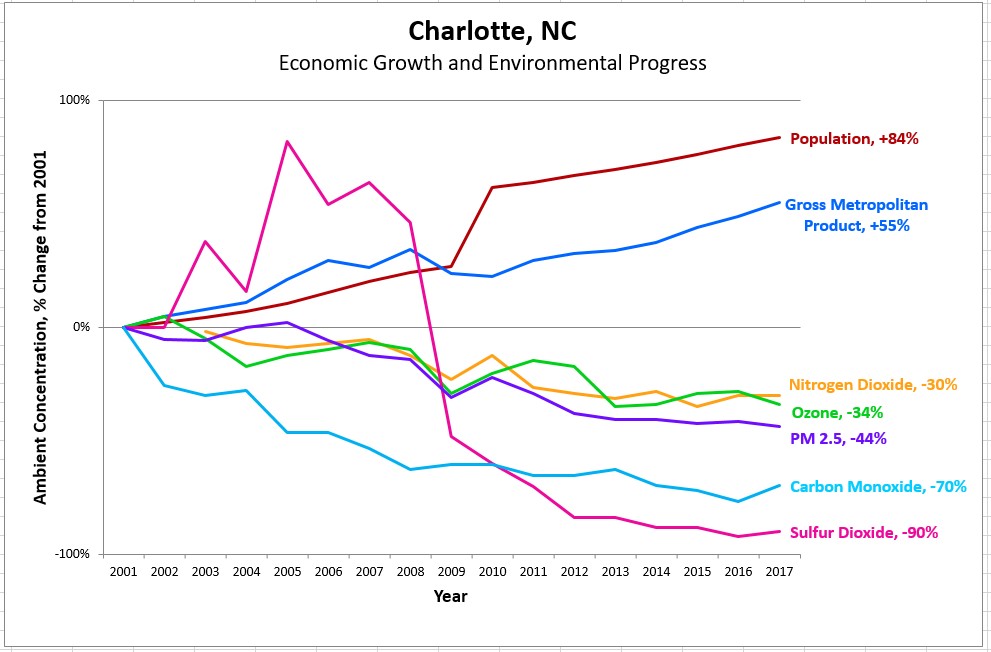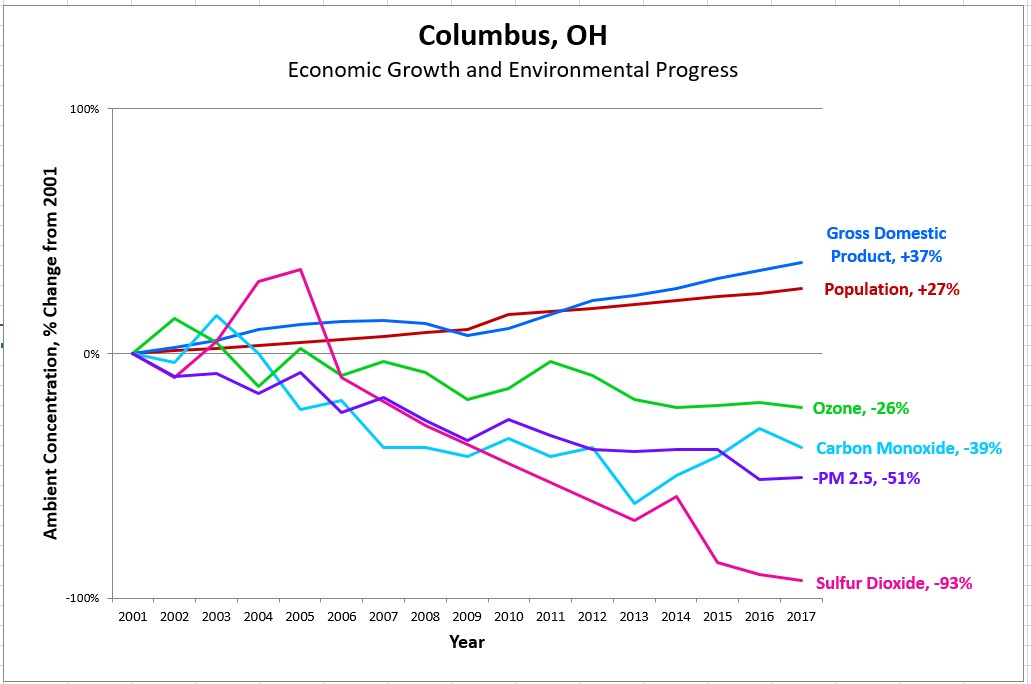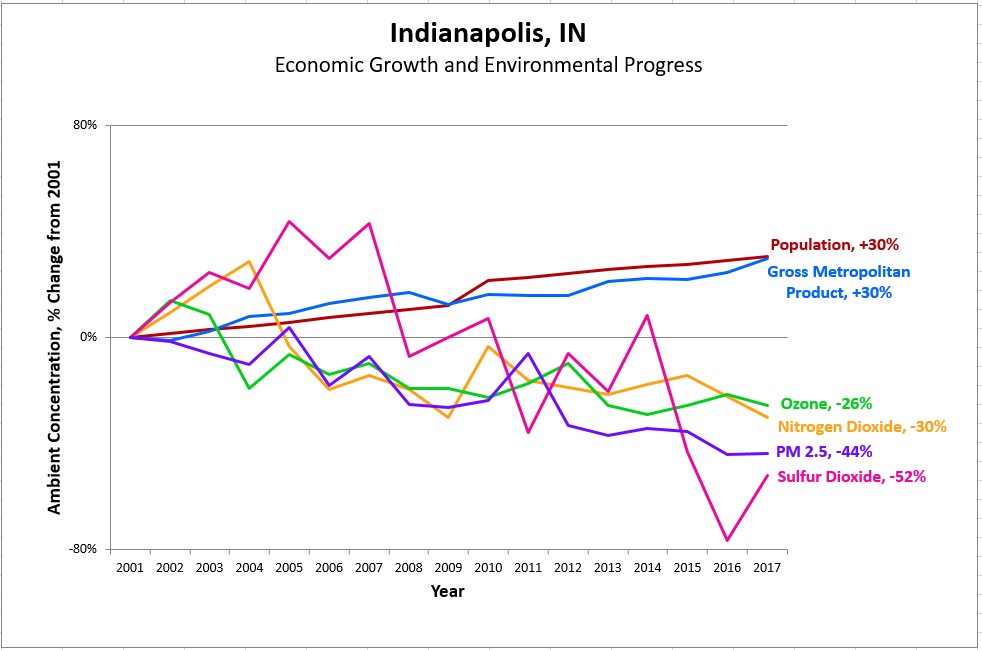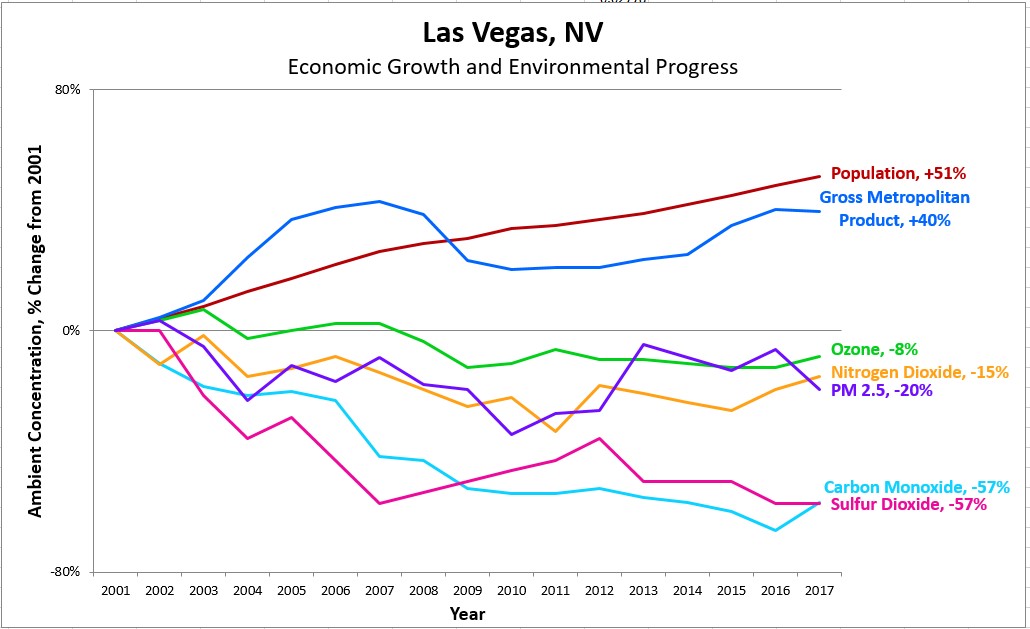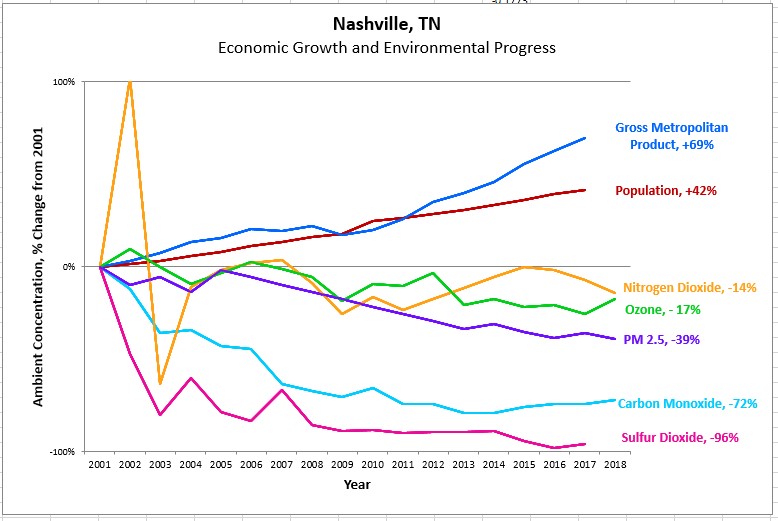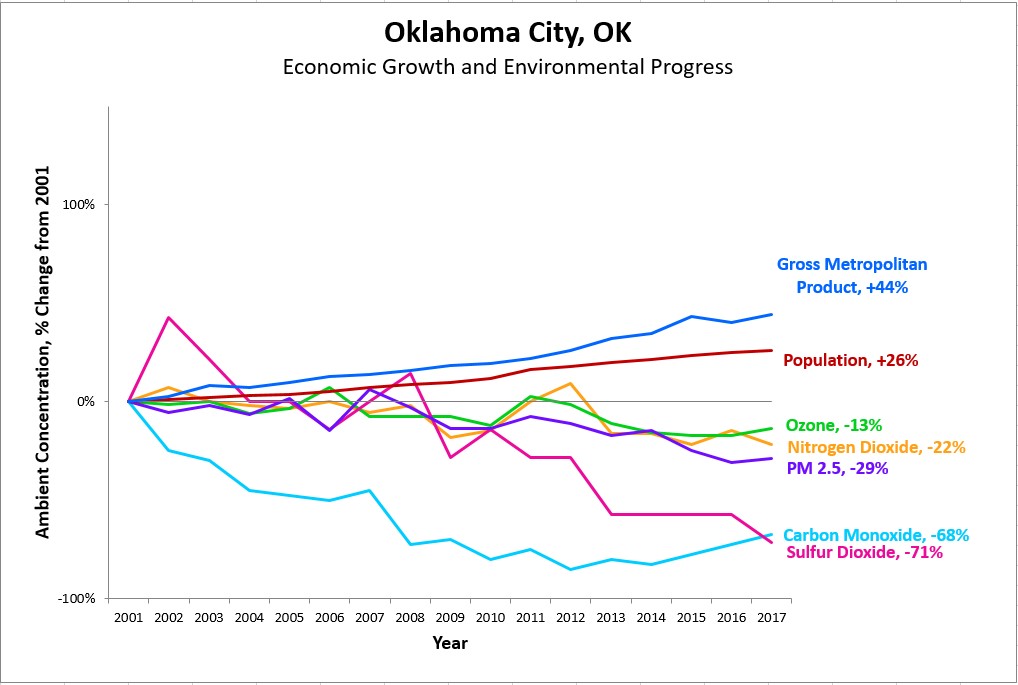Earlier this month, the Chamber’s Global Energy Institute rolled out our “American Energy: Cleaner, Stronger” agenda. GEI Acting President Christopher Guith summarized the effort thusly:
“The U.S. energy industry has been among the most innovative sectors of the economy, and will continue to make America cleaner and stronger. Energy companies are investing in innovation and technology which is making our air cleaner even while our economy and energy security are increasing. Our American Energy: Cleaner, Stronger agenda presents a realistic alternative to addressing energy and environmental issues that has broad bipartisan public support.”
As we celebrate Earth Day, we are taking a closer look at the foundations of the “Cleaner” aspect of our effort—the specific “hows” and “whats” of U.S. air quality progress, which is perhaps best described by an organization of state officials as “The Greatest Story Seldom Told.”
In many ways, GEI’s agenda is rooted in an effort to amplify and address Americans’ priorities as they relate to energy, the environment, climate change, and the quality of the air that they breathe. Our own polling shows that voters support a “cleaner, stronger” agenda that uses more American energy and continues environmental progress, and does so through investments in innovation and technology. This contrasts with an approach driven by massive regulatory interventions such as those called for in the Green New Deal. In short, voters care deeply about environmental progress, but strongly prefer an innovation-driven focus as the best way to get there.
As part of our efforts, GEI will also be addressing the troubling disconnect between Americans’ perceptions of the state of the environment and its actual quality. In March, Gallup released its annual survey of Americans’ views on a number of environmental issues. The findings show that an incredible 64% of Americans believe that the quality of the environment in the U.S. is getting worse—a 7% increase from just two years ago. With respect to air quality specifically, 74% of Americans say they worry about air pollution either a great deal or a fair amount. While this figure is 4 percentage points lower than in 2017, it is still incredibly high.
With that in mind, let’s take a closer, sector-by-sector look at some of the important progress that those 74% of Americans are likely unaware of:
Cleaner Electricity
The electric power sector is leading the way in emissions reductions, and has a great story to tell. Consider:
- Between 1990 and 2017, emissions of sulfur dioxide (SO2) and nitrogen oxides (NOX) from electricity generation were reduced by 92% and 84%, respectively.
- Since 2005, power sector carbon dioxide (CO2) emissions have fallen by 28%, powered in large part thanks to the shale revolution making natural gas more plentiful and affordable.
- Nuclear energy remains the largest source of emissions-free electricity, with 98 reactors in 30 states generating about 55% of the nation’s emissions-free electricity.
- Emissions free wind and solar generation is growing rapidly, and future technological breakthroughs in these areas as well as emergent technologies such as grid-scale storage, advanced nuclear, and carbon capture and sequestration hold even more promise for the future.
- Energy efficiency also contributes greatly to this progress. It now takes 40% percent less energy to produce a dollar of GDP than it did in 1990.
- By the end of 2020, owners of coal-fired power plants will have invested more than $127 billion in emissions controls—a major reason why Environmental Protection Agency (EPA) data show emissions per kilowatt-hour of coal-fired generation were reduced by 93% between 1970 and 2017.
- As we look to the future, the power sector will not only continue to get cleaner, it will enable other sectors to reduce emissions as well. Advances in the efficiency and affordability of battery storage technologies have enabled the introduction of over 40 different models of electric vehicles, sparking a trend that is only expected to accelerate.
- Moreover, the Energy Information Administration’s (EIA) latest 2019 forecast suggests that even as U.S. electricity generation grows by 9% between 2018 and 2030, we will nonetheless benefit from declining emissions of SO2 (5%), NOX (23%), mercury (19%), and CO2 (8%).
Cleaner Transportation
On the topic of transportation, there are more than 260 million registered vehicles in the United States, many of which sit in daily traffic jams in urban areas around the country. We’ve all been stuck in traffic like this, but most of the time we don’t think twice about rolling the windows down when the weather is nice. It hasn’t always been this way, but decades of research and collaboration between industry and all levels of government have contributed to steady U.S. air quality improvements resulting from the development and widespread use of advanced powertrains, sensors, and emissions control technologies. For example:
- Since 2000, EPA data shows that transportation emissions of ozone-forming nitrogen oxides and volatile organic compounds (VOCs) have declined by 49% and 66%, respectively, even as total vehicle miles traveled increased by 13%. During the same period, SO2 emissions have decreased an incredible 86%.
- What about CO2? According to the Auto Alliance, fleet-wide automobile CO2 emissions are 21% below 2005 levels on a per-mile basis.
- Government and industry are working collaboratively to address emissions from medium- and heavy-duty trucks as well. In November, EPA Administrator Wheeler announced a Cleaner Trucks Initiative to update standards for NOX emissions from heavy duty trucks and engines. Meanwhile, Congress is advancing legislation to expand funding for the Chamber-supported Diesel Emissions Reduction Act (DERA), a program that provides grants to replace or upgrade older truck engines, often reducing pollutant emissions by more than 90%.
- By 2025, it is expected that ozone-forming emissions of hydrocarbons and nitrogen oxides from passenger vehicles will have dropped 99.8% since emissions controls were first implemented.
Cleaner Manufacturing and Industry
The contributions of America’s industrial sector to air quality improvements are often overlooked, but they shouldn’t be.
- According to EPA’s National Emissions Inventory, industrial emissions of SO2, NOX, and fine particulate matter (PM2.5) have declined by 70%, 34%, and 18%, respectively, since 2000.
- These successes are driven by efforts such as those in the refining sector, which has invested more than $100 billion over the past decade to enhance operations and produce cleaner fuels. In fact, the U.S. refining industry’s investments in advanced technologies have it positioned to provide global leadership ahead of new international standards on sulfur emissions from the shipping industry. While shipping comprises only transportation fuel demand, it currently accounts for about 90 percent of sulfur emissions. American refiners’ efforts in this area are helping to clean air not just in the U.S., but around the world.
- Finally, while less directly linked to energy, the Chamber-supported Kigali Amendment to the Montreal Protocol treaty will help result in a phase-down of hydrofluorocarbons—or HFCs, which are used in applications such as aerosols, refrigeration, and air conditioning—by more than 80 percent over the next 30 years. American businesses are leading the push for U.S. ratification of this important international agreement.
Cleaner Energy Production
It is no secret that American energy production is stronger than ever. But did you know that the methane emissions intensity from that production has been reduced dramatically?
- Data from EPA and EIA indicate that between 2005 and 2017, a period when oil and natural gas production skyrocketed by 81% and 51%, methane emissions from these activities remained essentially flat. That’s because methane emissions per barrel of oil or cubic foot of natural gas produced declined by a very large 43% and 36%, respectively.
Cleaner, Stronger Economy
Add these success stories up sector by sector, and it should come as no surprise that economy-wide progress on air quality tracks them very closely. As EPA highlights in its annual State of the Air report and in the striking chart below, since 1970 the U.S. economy has grown by 262%, and population has grown by 59%, while nearly all pollutants of concern have fallen substantially (here is the same chart with a 1980 baseline). While greenhouse gas emissions are the exception to this rule, first rising modestly over this time period, they have fallen 13% since 2005.
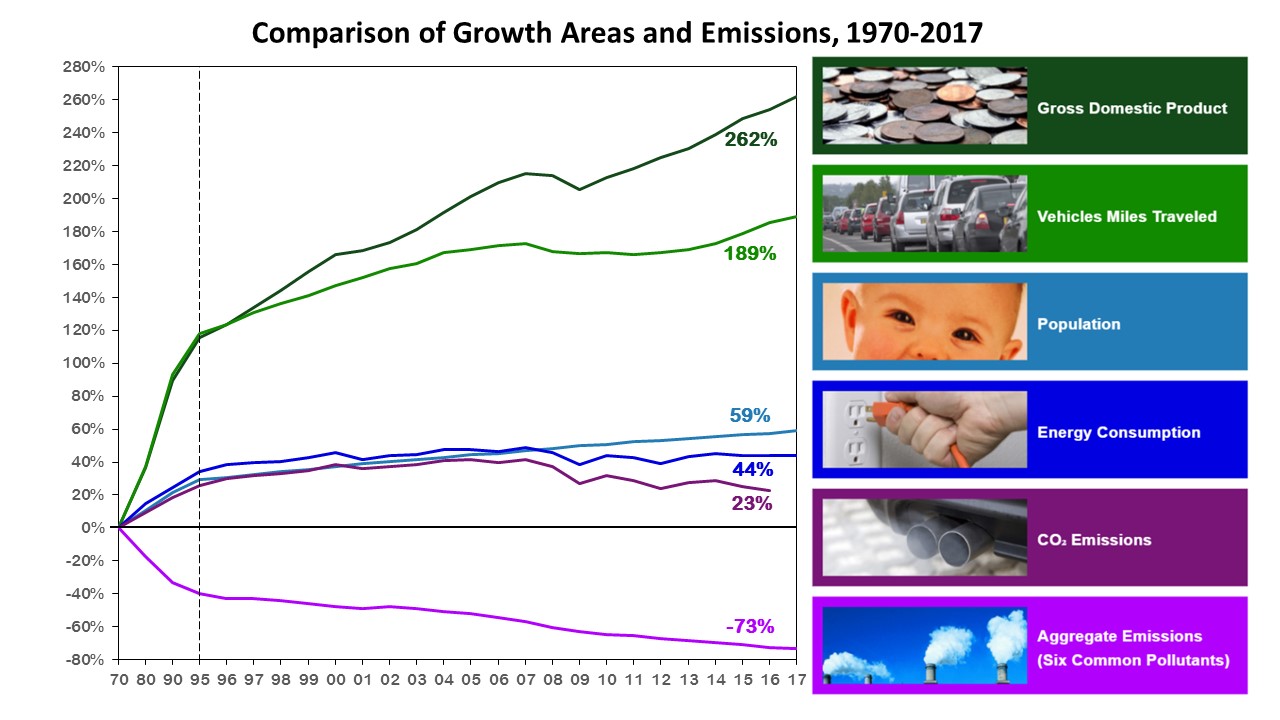 These successes are the result of collaborative efforts among states, localities, and the federal government, working together with industry, to develop and incorporate cleaner technologies without which these air quality improvements could not have been possible. Recent history is proof that a clean, healthy environment and economic growth are not mutually exclusive, and ultimately, this is the essence of America’s “Cleaner, Stronger” energy economy.
These successes are the result of collaborative efforts among states, localities, and the federal government, working together with industry, to develop and incorporate cleaner technologies without which these air quality improvements could not have been possible. Recent history is proof that a clean, healthy environment and economic growth are not mutually exclusive, and ultimately, this is the essence of America’s “Cleaner, Stronger” energy economy.
If you’re wondering how this progress compares internationally, or how it translates at the local level, look no further. Below we have compiled illustrative data from EPA’s air quality statistics database comparing ambient outdoor pollutant concentration in the U.S. and its major metropolitan areas to other countries and cities around the world, as well as charts illustrating progress at major U.S. cities.
This is not to suggest that our work is done—there is still important progress that needs to be made—but this Earth Day, let’s take a moment to celebrate just how much environmental progress we’ve made. And should Gallup call you for its next survey of public views on environmental progress, keep the “Greatest Story Seldom Told” top of mind!

